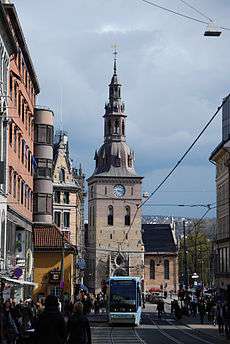Please tell us which country and city you'd like to see the weather in.

Diocese of Oslo
Oslo bishopric is the Church of Norway's bishopric for the municipalities of Oslo, Asker and Bærum. It is one of Norway's five traditional bishoprics and was founded around the year 1070.
History
Oslo was established as a diocese in 1068. It was originally a suffragan of the archdiocese of Hamburg-Bremen, from 1104 on of that of Lund and starting from 1152 on of Nidaros. It then covered the (modern) counties of Oslo, Akershus, Buskerud (except Hallingdal), Hedmark (except the northern part of Østerdalen), Oppland (except Valdres), Telemark, Vestfold and Østfold, and the province of Bohuslän, and the parishes of Idre and Särna.
The Diocese of Hamar was established and separated from Oslo in 1152, but it was again merged with Oslo in 1541 (together with the northern part of Østerdalen from Diocese of Nidaros). The regions of Hallingdal and Valdres were transferred from Diocese of Stavanger to Oslo in 1631. (But Oslo had to give the upper part of Telemark to Stavanger in return.) The parishes of Idre and Särna were lost to Sweden in 1644, and the province of Bohuslän was lost in 1658. Hamar (with Hedmark and Oppland) was again separated from Oslo in 1864. The rest of Telemark was transferred to Diocese of Kristiansand (see Diocese of Agder og Telemark) the same year. The Diocese of Tunsberg (with Vestfold and Buskerud) was established and separated from Oslo in 1948. The Diocese of Borg (with Akershus and Østfold) was established and separated from Oslo in 1969.

Roman Catholic Diocese of Oslo
The Roman Catholic Diocese of Oslo (Latin: Osloënsis) is an exempt diocese located in the city of Oslo in Norway.
Parishes
The territory is divided into 25 parishes, located in the following sites: Oslo (3), Moss, Askim, Fredrikstad, Halden, Lillestrøm, Hamar, Kongsvinger, Lillehammer, Jessheim, Hønefoss, Stabekk, Drammen, Fagernes, Tønsberg, Larvik, Sandefjord, Porsgrunn, Arendal, Kristiansand, Stavanger, Haugesund and Bergen.
History
By 1070? the see was established as the Diocese of Oslo, and the bishop was seated at St. Hallvard's Cathedral. In 1537 - in the course of the Lutheran Reformation in Denmark-Norway and Holstein - Christian III of Denmark suppressed the Catholic episcopates at the Norwegian sees. Thereafter Lutheranism prevailed in Scandinavia.
In 1582 the stray Catholics in Norway and elsewhere in Northern Europe were placed under the jurisdiction of a papal nuncio in Cologne. The Congregation de propaganda fide, on its establishment in 1622, took charge of the vast missionary field, which - at its third session - it divided among the nuncio of Brussels (for the Catholics in Denmark and Norway), the nuncio at Cologne (much of Northern Germany) and the nuncio to Poland (Finland, Mecklenburg, and Sweden).

Oslo
Oslo (English pronunciation: /ˈɒzloʊ/, OZ-loh,Norwegian pronunciation: [ˈuʂˈlu] (![]() listen) or, rarer [ˈusˈlu] or [ˈuʂlu]) is the capital and the most populous city in Norway.
listen) or, rarer [ˈusˈlu] or [ˈuʂlu]) is the capital and the most populous city in Norway.
Oslo constitutes both a county and a municipality. Founded in the year 1040, and established as a "kaupstad" or trading place in 1048 by King Harald III, the city was elevated to a bishopric in 1070 and a capital under Haakon V around 1300. Personal unions with Denmark from 1397 to 1523 and again from 1536 to 1814 and with Sweden from 1814 to 1905 reduced its influence. After being destroyed by a fire in 1624, the city was moved closer to Akershus Fortress during the reign of King Christian IV and renamed Christiania in his honour. It was established as a municipality (formannskapsdistrikt) on 1 January 1838. Following a spelling reform, it was known as Kristiania from 1877 to 1925, at which time its original Norwegian name was restored.
Oslo is the economic and governmental centre of Norway. The city is also a hub of Norwegian trade, banking, industry and shipping. It is an important centre for maritime industries and maritime trade in Europe. The city is home to many companies within the maritime sector, some of which are among the world's largest shipping companies, shipbrokers and maritime insurance brokers. Oslo is a pilot city of the Council of Europe and the European Commission intercultural cities programme.

Oslo Central Station
Oslo Central Station (Norwegian: Oslo sentralstasjon, abbreviated Oslo S) is the main railway station in Oslo, and the largest railway station within the entire Norwegian railway system. It is the terminus of Drammen Line, Gardermoen Line, Gjøvik Line, Hoved Line and Østfold Line. It serves express, regional and local rail services by four companies. The railway station is owned and operated by Norwegian National Rail Administration and was opened in 1980.
Oslo Central was built on the site of the older Oslo East Station (Oslo Østbanestasjon, Oslo Ø), the combining of the former east and west stations being made possible by the opening of the Oslo Tunnel. Oslo Central has nineteen tracks, thirteen of which have connections through the Oslo Tunnel. The station has two buildings, the original Oslo East building and the newer main building for Oslo Central. Each building houses a large shopping centre. The square in front of the station is called Jernbanetorget.
History
Two stations
Radio Stations - Oslo
SEARCH FOR RADIOS
Podcasts:
Oslo


